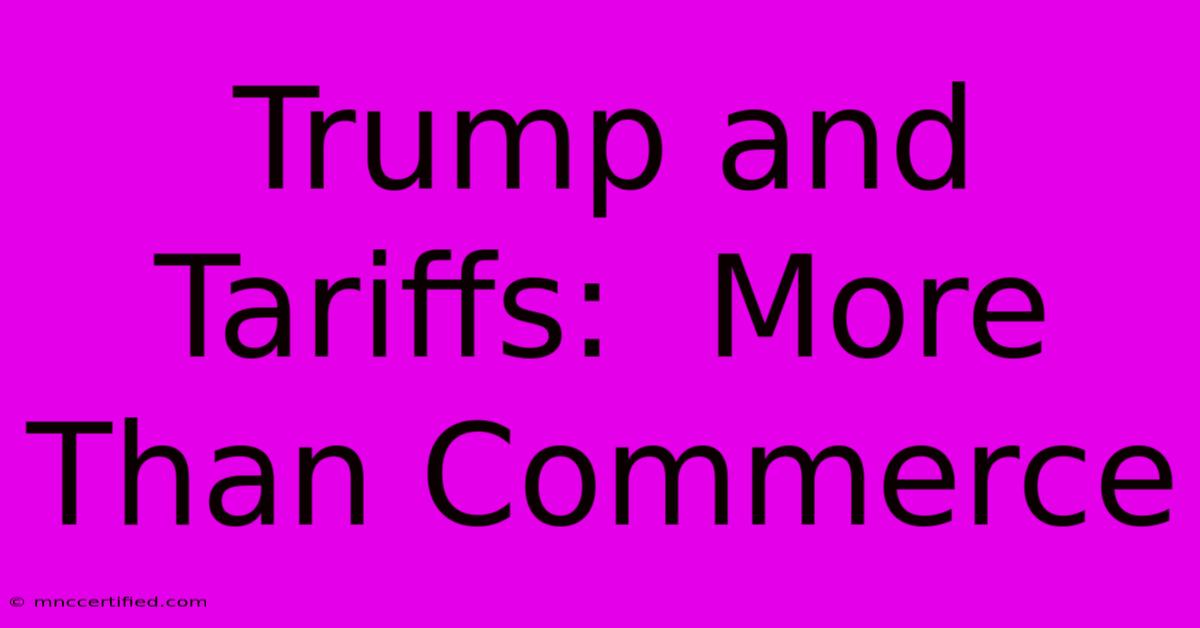Trump And Tariffs: More Than Commerce

Table of Contents
Trump and Tariffs: More Than Just Commerce
Donald Trump's presidency was marked by a significant shift in US trade policy, characterized by the widespread implementation of tariffs. While often framed as purely economic measures, the impact of Trump's tariffs extended far beyond simple commerce, significantly influencing geopolitical relations, domestic industries, and the global trading system. Understanding this multifaceted impact requires moving beyond simplistic analyses of trade balances and delving into the complex interplay of political strategy, economic consequences, and international relations.
The Economic Rationale (or Lack Thereof)
Trump's tariff strategy, ostensibly aimed at protecting American industries and correcting perceived trade imbalances, was met with considerable economic debate. His administration frequently cited the need to address trade deficits with China and other countries. However, economists widely disagree on the effectiveness of tariffs as a tool to achieve this goal.
Many argue that tariffs, while potentially benefiting specific domestic industries in the short term, often lead to higher prices for consumers, retaliatory tariffs from other countries, and disruptions to global supply chains. The "trade war" with China, triggered by Trump's tariffs, exemplifies these negative consequences, impacting both US and Chinese businesses, as well as global markets. Furthermore, the economic models used to justify the tariffs have been criticized for their assumptions and limitations. While certain sectors, like steel, might have seen temporary gains, the overall economic impact remains a subject of ongoing scrutiny and debate amongst experts.
Beyond the Numbers: Hidden Costs
The economic consequences go beyond simple trade statistics. The uncertainty created by the fluctuating tariff landscape hindered long-term investment decisions for businesses, both domestically and internationally. Supply chain disruptions led to production delays and increased costs, impacting businesses across numerous sectors. The impact on small and medium-sized enterprises (SMEs) was particularly significant, as they often lack the resources to navigate the complexities of a volatile trade environment.
Geopolitical Implications: A Weaponized Trade Policy
Trump's use of tariffs transcended pure economic policy, becoming a key instrument of his foreign policy. The imposition of tariffs was often linked to broader geopolitical goals, such as pressuring China on issues related to intellectual property theft, trade practices, and national security concerns. This approach signaled a departure from traditional multilateral trade diplomacy, moving towards a more unilateral and confrontational strategy.
This aggressive trade policy strained relationships with key allies, leading to concerns about the stability of the global trading system. The WTO (World Trade Organization), the cornerstone of global trade governance, faced challenges as Trump's actions often contradicted its principles. This shift towards trade as a geopolitical weapon raised questions about the long-term viability of collaborative international trade agreements.
The Impact on Alliances
The unpredictability of Trump's trade policies created uncertainty among US allies, undermining trust and eroding confidence in the reliability of future trade agreements. The imposition of tariffs on steel and aluminum imports, for instance, affected even close allies, highlighting a disregard for traditional trade partnerships. This approach jeopardized long-standing alliances and strained relations within the global community.
Domestic Political Ramifications: A Divisive Issue
Trump's tariff policy was not without its domestic political implications. While some sectors benefited from protectionist measures, others suffered from increased costs and reduced competitiveness. This resulted in a polarized response, with some praising the protection of American jobs while others criticizing the negative economic impact on consumers and businesses.
The debate around tariffs became deeply intertwined with broader political narratives, fueling divisions along partisan lines and highlighting the complexities of balancing economic interests with national security concerns. The long-term effects on the American economy and political landscape remain to be fully assessed.
Conclusion: A Legacy of Uncertainty
Trump's legacy on tariffs extends far beyond the simple mechanics of trade policy. His approach, marked by unpredictability and a focus on bilateral negotiations, significantly altered the landscape of global trade, impacting geopolitical relations, domestic economies, and the international governance of trade. While the immediate economic effects are subject to ongoing debate, the longer-term consequences of this significant policy shift remain to be fully understood and continue to influence international relations and trade practices. The question of whether the benefits outweighed the costs remains a crucial point of discussion and analysis for economists and political scientists alike.

Thank you for visiting our website wich cover about Trump And Tariffs: More Than Commerce. We hope the information provided has been useful to you. Feel free to contact us if you have any questions or need further assistance. See you next time and dont miss to bookmark.
Featured Posts
-
Austin Life Insurance Policies
Nov 27, 2024
-
Fort Lauderdale Home Insurance
Nov 27, 2024
-
Chiropractor No Insurance Cost
Nov 27, 2024
-
Uk Bank Holiday 2025 New Date
Nov 27, 2024
-
North Carolina Fires Football Coach Brown
Nov 27, 2024